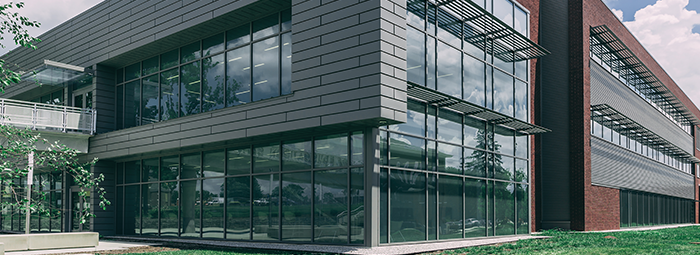
©2020 This excerpt taken from the article of the same name which appeared in ASHRAE Journal, vol. 62, no. 12, December 2020.
About the Author
Ben Hobbs, P.E., is a mechanical engineer at CMTA in Lexington, Ky.
Located in Lexington, Kentucky, the Bluegrass Community and Technical College (BCTC) Newtown Campus Science Building was constructed as a 63,938 ft2 (5940 m2), three-story building with administrative spaces, lecture classrooms, laboratory classrooms, and student commons areaws. The building is designed to accommodate approximately 850 students and staff, with approximately 40% used as lab space and the remaining area used as classroom and office space. The building was designed to achieve LEED Silver in accordance with the U.S. Green Building Council standard. The building is also designed to showcase how sustainable design can be safely applied to typical energy-intensive environments that require 24/7 operation and uncompromising indoor-environmental design approaches to maintain safe learning spaces.
Energy Efficiency
Laboratory buildings are some of the most energy-intensive buildings due to their ventilation requirements and simultaneous heating and cooling needs. The ASHRAE/IES Standard 90.1-2010, Appendix G baseline energy model generated for the Newtown Campus Science Building operated at an EUI of 127.9 kBtu/ft2·yr (403.5 kWh/m2). However, most labs seem to operate significantly higher than the baseline. Therefore, in addition to using the baseline energy model, the design team used the International Institute of Sustainable Labs (I2SL) and Department of Energy (DOE) databases of actual energy used by laboratory buildings to help lead the energy discussion as it relates to building systems.
These databases allow the design team to compare lab buildings in similar climate zones with similar fume hood densities and operational characteristics. The I2SL database indicated an energy usage of 381 kBtu/ft2 ·yr (1201.9 kWh/m2), while the DOE database showed an energy usage of 290 kBtu/ft2 ·yr (914.8 kWh/m2). These databases use actual energy performance in lieu of modeled data. The Newtown Campus Science Building was modeled and predicted to use 83.2 kBtu/ft2 ·yr (262.5 kWh/m2), and is currently operating at an EUI of 79.63 kBtu/ft2 ·yr (251.2 kWh/m2), which is one of the most energy-efficient community college buildings in the academic system.
Since laboratory buildings use simultaneous heating and cooling, a modular heat-recovery chiller was used in place of the traditional chiller and boiler cooling and heating plants. This system has the ability, when producing 45 °F (7.2 °C) chilled water, to simultaneously produce 120 °F (48.9 °C) water by capturing the heat rather than rejecting it. The HVAC design used two air-handling units to handle the heating and the cooling of the building and the required ventilation air. The laboratory spaces required one-pass-through air due to the high amount of exhaust with the fume hood, and, thus, a 100% outdoor air system was provided with a run-around heat recovery coil in the exhaust airstream.
The classroom and office spaces do not have this same requirement; therefore, a traditional VAV air-handling unit with heating and cooling coils was used to heat and cool these spaces. However, this unit did not provide the ventilation air to these spaces. The ventilation air was provided through the laboratory unit. The advantage of providing ventilation air via the 100% outside air lab unit to non-lab spaces in lieu of the traditional air-handler VAV system was the ability to use demand control ventilation via occupancy sensors and the energy recovery of the run-around loop.
To generate additional energy reduction, dual-contact occupancy sensors were provided to control the lights in the building and to reset the temperature set point during occupied times. In addition, the occupancy sensors were also able to be used to shut off ventilation air in the classroom and lab spaces during occupied hours because sensors were monitoring occupancy at all times.
Read the Full Article
ASHRAE Members have free access to the full-text PDF of this article as well as the complete ASHRAE Journal archives back to 1997 in the Free Member Access Area.
Non-members can purchase features from the ASHRAE Bookstore. Or, Join ASHRAE!
Return to Featured Article Excerpts
Return to ASHRAE Journal Featured Article Excerpts